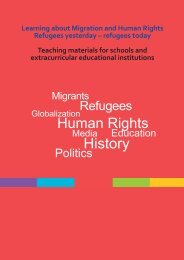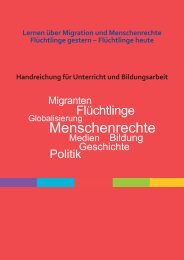IMMIGRATION IN ITALY By Laura Zanfrini* 1. From a source to a ...
IMMIGRATION IN ITALY By Laura Zanfrini* 1. From a source to a ...
IMMIGRATION IN ITALY By Laura Zanfrini* 1. From a source to a ...
- No tags were found...
Create successful ePaper yourself
Turn your PDF publications into a flip-book with our unique Google optimized e-Paper software.
European societies have <strong>to</strong> defend themselves. It was actually during that period, dominated byrestrictive policies and spontaneous migrant flows, that South-European countries, at the head ofwhich was Italy, began their transformation in<strong>to</strong> destination areas for heterogeneous flows arrivedout of any active recruitment policy, and destined <strong>to</strong> be introduced in the numerous niches of aneconomy that just in that period knew its transition <strong>to</strong> post-Fordism.The particular stage in which Italy knew its migra<strong>to</strong>ry transition did considerably weighupon the analyses dedicated <strong>to</strong> this theme. In the other European countries, immigration had beenstudied as an industrial phenomenon, which involved themes and problems connected <strong>to</strong> classrelations and industrial clash, identification processes with the working class, the relationshipbetween local and immigrant workers, trade union actions, social mobility strategies, and socialmovements. The social integration of immigrants and of their families, and all the problemsassociated with inter-ethnic coexistence started <strong>to</strong> attract the attention of both researchers andgovernmental authorities at a later stage, as soon as immigration began <strong>to</strong> transform itself from asubstantially economic matter in<strong>to</strong> a political one. To some extent, in the Italian case this processwas opposite, since the economic functionality of immigration was far from being taken forgranted. Thanks <strong>to</strong> the first studies, carried out in several local realities, it was possible <strong>to</strong> outline amap, albeit fragmentary and incomplete, of immigrant work. <strong>From</strong> the Tunisians employed in thefishing industry at Mazara del Vallo (Sicily) <strong>to</strong> the thousands of seasonal labourers working in theMediterranean agricultural industry, from the street vendors wandering from the Salen<strong>to</strong> <strong>to</strong> theRomagna Riviera <strong>to</strong> the large crowds of women working as domestic helpers in the cities, and soon, up <strong>to</strong> the first experiments of immigrants’ inclusion in some industrial districts in EmiliaRomagna and their early entrepreneurial activity forms. The first two regularizations, launchedrespectively in 1986 and 1990, allowed the emergence of dozen of thousands work relations, butmost of all allowed newly regularized workers <strong>to</strong> gain access <strong>to</strong> the opportunities that in themeantime had opened in the Italian labour market, or more precisely, in the northern part of thecountry. In confirmation of the chronic dualism characterizing the national economy, researchersidentified that a mobility process inside the country was in progress, following the direction of the1950s and 1960s migrations from the south <strong>to</strong> the north of the country. Provinces such as Bergamo,Brescia, Modena, Reggio Emilia, Verona, Vicenza, Tren<strong>to</strong>, Treviso (besides, obviously, Milan),characterized by a widespread economic welfare, unemployment rates much below the nationalaverage, a growing access <strong>to</strong> secondary and tertiary education, thus making workers’ turnoverincreasingly problematic. And just in those local realities a peculiar integration model began <strong>to</strong> takeshape (along with the typical urban model, characterized by a prevalence of the tertiary industryproviding services <strong>to</strong> enterprises and families and by a marked foreign presence “feminization”),whose ideal-type figure is the immigrant worker employed in small and medium enterprises,particularly in the metal-mechanical and building industries. On the basis of those empiricalevidences, several authors identified different terri<strong>to</strong>rial models of immigrants’ integration, whereimmigration was assumed as a sort of “litmus test” of the peculiar characteristics of local labourmarkets. The second significant heritage of that season is the idea of complementarity between localand immigrant labour force, an idea almost unanimously shared by researchers despite thepersisting employment difficulties for an absolutely non-negligible share of the Italian labour force,and motivated referring <strong>to</strong> the growing au<strong>to</strong>nomy of the domestic labour supply.The idea of complementarity will begin a sort of axiom in the analysis of migrants’ role inthe Italian labour market. In any case, <strong>to</strong> understand phenomena that have been increased farbeyond all expectations, it is necessary <strong>to</strong> take in<strong>to</strong> account some characters of Italian economicsystem:- The very high incidence of non-qualified and manual workers within the employment and thenew hirings. In all advanced economies, the advent of the service society had stimulated thegrowth of non-qualified jobs – often “bad jobs” – largely filled by migrant workers. But in Italythis demand is also fed by traditional sec<strong>to</strong>rs, and it often concerns skilled manual workers, evenmore difficult <strong>to</strong> recruit. Heavy jobs, mobility depending on building yard transfer, exposure <strong>to</strong><strong>Laura</strong> Zanfrini, Immigration in Italy, June 30, 2013. 11







